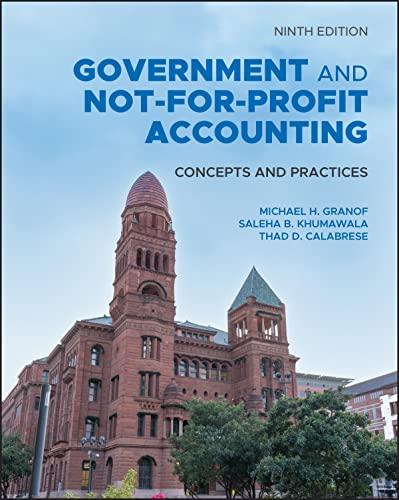Question
MKG is a medium sized accounting firm located in Little Rock, Arkansas. They provide two types of services, audit and tax. MKG has two types
MKG is a medium sized accounting firm located in Little Rock, Arkansas. They provide two types of services, audit and tax. MKG has two types of costs - direct labor, and overhead, which includes everything other than direct labor. Direct labor is traced directly from time sheets to specific audit jobs and tax returns. Overhead costs consists of facility costs (rent on their office space, furnishings, utilities, insurance, etc.) and indirect labor (clerical workers and assistants who do not have direct contact with clients). Facilities costs make up approximately 70% of total overhead costs, with indirect labor making up the rest.
This problem considers the cost allocation during the current year. At the start of the current year, MKG had two audit jobs "in process", but no tax returns "in process". From a costing perspective we can think about these as work-in-process, in that MKG accumulates costs in the jobs until the jobs are completed, at which time all revenue and costs are recognized.
Jobs in process, as of January 1 (*): Direct Labor Overhead Revenue (*)
Audit job #456 $12,000 $8,000 $50,000
Audit job #459 $4,000 $3,000 $10,000
(*) The costs are those incurred so far, i.e., those incurred in the prior year. The revenue is the total revenue for the job, which will be recorded as revenue in the current year.
There were no jobs or returns in process at the end of the current year.
Overhead costs at MKG are allocated first to the audit and tax departments based on the actual number of direct labor hours in each department during the year, using a pre-determined (normal) overhead rate. MKG does NOT pro-rate estimation errors. Within each department, allocations are all made using actual costing, and using a weighted average cost flow assumption. The audit department allocates overhead to audit jobs based on customer revenue, while the tax department allocates overhead to tax returns based on the number of tax returns completed.
MKGs firm-level budget for the current year called for $2,800,000 in overhead, but actual overhead was $12,000 higher than budgeted.
Audit Department: During the current year, the audit department budgeted for 20,000 hours at an average of $50 per hour in direct labor. The budget called for 625 jobs, with a total revenue of $2,750,000. The audit department actually had 22,000 direct labor hours, at a total cost of $1,100,000. During the year, the audit department completed 600 jobs (including jobs #456 and #459), with an actual total revenue of $2,475,000.
Tax Department: During the current year, the tax department budgeted for 50,000 hours at an average of $60 per hour in direct labor. The budget called for 900 returns, with a total revenue of $7,200,000. The tax department actually had 52,000 direct labor hours, at a total cost of $3,120,000. During the year, the tax department completed 1000 returns, with an actual total revenue of $7,800,000.
1. Tax return #1562 had actual direct labor of 120 hours, at an average rate of $55 per hour, and generated revenue of $6,000. How much total cost is included in cost of services for the year for tax return #1562? __________
2. Audit job #612 had actual direct labor of 100 hours, at a total direct labor cost of $8,000, and generated revenue of $15,000. How much total cost is included in cost of services for the year for audit job #612? __________
3. At the end of the year, MKG will adjust their cost of services for over or under applied overhead. What effect will this adjustment have on MKGs net income for the year? Your answer should include both an amount and a direction (e.g., increase by $10, decrease by $20, or no effect). __________
4. As discussed above, MKG allocates overhead to the two departments based on direct labor hours. Name one other possible alternative driver for the overhead (it is not necessary that your alternative be computable given the information in the problem).
Give one reason why MKG might prefer to use your alternative rather than direct labor hours (one or two sentences).
Give one reason why MKG might prefer to use direct labor hours rather than your alternative (one or two sentences).
5. A colleague has pointed out that although we allocate tax department overhead by number of returns, it is probably not correct that every return requires the exactly the same amount of overhead resources. What are three factors that MKG would want to consider before deciding whether or not to increase the accuracy of their cost system (by, for example, finding a better driver)? Be as specific as possible, and be clear how the factor would impact the decision to increase the accuracy or not. It is not necessary that the needed information be included in the problem (one or two sentences each).
Factor 1.
Factor 2.
Factor 3.
Step by Step Solution
There are 3 Steps involved in it
Step: 1

Get Instant Access to Expert-Tailored Solutions
See step-by-step solutions with expert insights and AI powered tools for academic success
Step: 2

Step: 3

Ace Your Homework with AI
Get the answers you need in no time with our AI-driven, step-by-step assistance
Get Started


